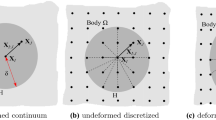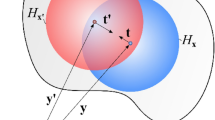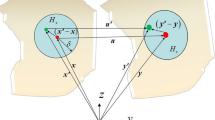Abstract
The computational methods for the shocks modeling would face two major challenges: (1) the severe damage with large deformations and (2) the intermittent waves. Peridynamics (PD) takes the integral form of its governing equation and shows exceeding advantages in modeling large deformation and severe damage. On the other hand, the propagation of intermittent wave within the PD based numerical system often experiences oscillatory instability. It can be attributed to the instability in time domain and the zero energy mode. Aiming for addressing such issues, the temporally stabilized PD methods are proposed in the present work. The stabilization force component is introduced and the general framework of stabilized PD methods is established. The formulation of the corresponding force state is proposed based on the features of the spurious oscillations. The case studies indicate that the stabilized PD methods are capable of effectively suppressing the nonphysical oscillations and are well-suited for the bond-based as well as the state-based PD formulations.












Similar content being viewed by others
References
Amani J, Oterkus E, Areias P, Zi G, Nguyen-Thoi T, Rabczuk T (2016) A non-ordinary state-based peridynamics formulation for thermoplastic fracture. Int J Impact Eng 87(1):83–94
Baek J, Chen JS, Zhou G, Arnett KP, Hillman MC, Hegemier G, Hardesty S (2021) A semi-Lagrangian reproducing kernel particle method with particle-based shock algorithm for explosive welding simulation. Comput Mech 67(6):1601–1627
Barenblatt GI (1959) The formation of equilibrium cracks during brittle fracture. General ideas and hypotheses. Axially-symmetric cracks. J Appl Math Mech 23(3):622–636
Bažant ZP, Luo W, Chau VT, Bessa MA (2016) Wave dispersion and basic concepts of peridynamics compared to classical nonlocal damage models. J Appl Mech 83(11):111004
Belytschko T, Black T (1999) Elastic crack growth in finite elements with minimal remeshing. Int J Numer Methods Eng 45(5):601–620
Belytschko T, Liu W, Moran B (2000) Nonlinear finite elements for continua and structures. Wiley, Hoboken
Bessa M, Foster J, Belytschko T, Liu WK (2014) A meshfree unification: reproducing kernel peridynamics. Comput Mech 53(6):1251–1264
Butt SN, Timothy JJ, Meschke G (2017) Wave dispersion and propagation in state-based peridynamics. Comput Mech 60(5):725–738
Caramana EJ, Shashkov MJ, Whalen PP (1998) Formulations of artificial viscosity for multi-dimensional shock wave computations. J Comput Phys 144(1):70–97
Dukowicz JK (1985) A general, non-iterative Riemann solver for Godunov’s method. J Comput Phys 61(1):119–137
Foster JT, Xu X (2018) A generalized, ordinary, finite deformation constitutive correspondence model for peridynamics. Int J Solids Struct 141:245–253
Foster JT, Silling SA, Chen WW (2010) Viscoplasticity using peridynamics. Int J Numer Methods Eng 81(10):1242–1258
Gerstle W, Sau N, Aguilera E (2007) Micropolar peridynamic constitutive model for concrete. IASMiRT, Toronto
Gibbs JW (1899) Fourier’s series. Nature 59(1539):606
Godunov SK (1959) A difference scheme for numerical computation of discontinuous solutions of equations in fluid dynamics. Math Sb 47:271–306
Gu X, Zhang Q, Huang D, Yv Y (2016) Wave dispersion analysis and simulation method for concrete shpb test in peridynamics. Eng Fract Mech 160:124–137
Han F, Liu S, Lubineau G (2020) A dynamic hybrid local/nonlocal continuum model for wave propagation. Comput Mech 67:385–407
Harten A, Engquist B, Osher S, Chakravarthy SR (1987) Uniformly high order accurate essentially non-oscillatory schemes, iii. In: Yousuff Hussaini M, van Leer B, Van Rosendale J (eds) Upwind and high-resolution schemes, pp 218–290
Hu W, Ha YD, Bobaru F (2012) Peridynamic model for dynamic fracture in unidirectional fiber-reinforced composites. Comput Methods Appl Mech Eng 217–220(4):247–261
Kilic B, Agwai A, Madenci E (2009) Peridynamic theory for progressive damage prediction in center-cracked composite laminates. Compos Struct 90(2):141–151
Landshoff R (1955) A numerical method for treating fluid flow in the presence of shocks. Technical report, Los Alamos National Lab NM
Lapidus L, Pinder GF (2011) Numerical solution of partial differential equations in science and engineering. Wiley, Hoboken
Madenci E, Oterkus E (2014) Peridynamic theory. Springer, Berlin
Madenci E, Oterkus S (2016) Ordinary state-based peridynamics for plastic deformation according to von Mises yield criteria with isotropic hardening. J Mech Phys Solids 86:192–219
Mitchell JA (2011) A nonlocal ordinary state-based plasticity model for peridynamics. Technical report, Sandia National Lab. (SNL-NM), Albuquerque, NM (United States)
Roth MJ, Chen JS, Danielson KT, Slawson TR (2016) Hydrodynamic meshfree method for high-rate solid dynamics using a Rankine–Hugoniot enhancement in a Riemann-scni framework. Int J Numer Methods Eng 108(12):1525–1549
Roth MJ, Chen JS, Slawson TR, Danielson KT (2016) Stable and flux-conserved meshfree formulation to model shocks. Comput Mech 57(5):773–792
Shu CW, Osher S (1988) Efficient implementation of essentially non-oscillatory shock-capturing schemes. J Comput Phys 77(2):439–471
Silling SA (2000) Reformulation of elasticity theory for discontinuities and long-range forces. J Mech Phys Solids 48(1):175–209
Silling SA, Askari A (2014) Peridynamic model for fatigue cracking. Technical report, SAND2014-18590. Sandia National Laboratories, Albuquerque
Silling SA, Askari E (2005) A meshfree method based on the peridynamic model of solid mechanics. Comput Struct 83(17–18):1526–1535
Silling SA, Epton M, Weckner O, Xu J, Askari E (2007) Peridynamic states and constitutive modeling. J Elast 88(2):151–184
Tupek M, Radovitzky R (2014) An extended constitutive correspondence formulation of peridynamics based on nonlinear bond-strain measures. J Mech Phys Solids 65:82–92
Tupek MR, Rimoli JJ, Radovitzky R (2013) An approach for incorporating classical continuum damage models in state-based peridynamics. Comput Methods Appl Mech Eng 263(8):20–26
Weckner O, Abeyaratne R (2005) The effect of long-range forces on the dynamics of a bar. J Mech Phys Solids 53(3):705–728
Wilbraham H (1848) On a certain periodic function. Camb Dublin Math J 3:198–201
Wildman RA (2019) Discrete micromodulus functions for reducing wave dispersion in linearized peridynamics. J Peridynamics Nonlocal Model 1(1):56–73
Wildman RA, Gazonas GA (2014) A finite difference-augmented peridynamics method for reducing wave dispersion. Int J Fract 190:39–52
Wilkins ML (1980) Use of artificial viscosity in multidimensional fluid dynamic calculations. J Comput Phys 36(3):281–303
Xu XP, Needleman A (1994) Numerical simulations of fast crack growth in brittle solids. J Mech Phys Solids 42(9):1397–1434
Yaghoobi A, Chorzepa MG (2017) Fracture analysis of fiber reinforced concrete structures in the micropolar peridynamic analysis framework. Eng Fract Mech 169:238–250
Zhang Q (2017) Finite difference methods for partial differential equations. China Science Publishing, Beijing
Zhang X, Xu Z, Yang Q (2019) Wave dispersion and propagation in linear peridynamic media. Shock Vib 9:9528978
Zhou G, Hillman M (2020) A non-ordinary state-based Godunov-peridynamics formulation for strong shocks in solids. Comput Part Mech 7(2):365–375
Zhou X, Wang Y, Shou Y, Kou M (2018) A novel conjugated bond linear elastic model in bond-based peridynamics for fracture problems under dynamic loads. Eng Fract Mech 188:151–183
Zhu QZ, Ni T (2017) Peridynamic formulations enriched with bond rotation effects. Int J Eng Sci 121:118–129
Zimmermann M (2005) A continuum theory with long-range forces for solids. PhD thesis, Massachusetts Institute of Technology
Author information
Authors and Affiliations
Corresponding author
Additional information
Publisher's Note
Springer Nature remains neutral with regard to jurisdictional claims in published maps and institutional affiliations.
Appendix A: Von Neumann stability analysis for stabilized PD
Appendix A: Von Neumann stability analysis for stabilized PD
Here, the von Neumann stability analysis for stabilized PD is presented to show the effectiveness of the Method I. We conduct the analysis in Sect. 3.1 again, and the Eq. (25) turns to be:
where \(\ddot{u}^n(x)=[u^{n+1}(x)-2u^n(x)+u^{n-1}(x)]/{\Delta t}^2\), \(C(\xi )=c/\left\| {\xi }\right\| \) and \(D(\xi )=b \alpha _{\text{ p }}/\left\| {\xi }\right\| \) in 1-D. Similarily, let
where \(\kappa \) is a positive real number and \(\lambda \) is a complex number. Then Eq. (73) can be written as:
Actually, \(D(\xi )\) can be regarded as \(\beta C(\xi )\) and with the definition in Eq. (28), we obtain
where \(\beta =b \alpha _{\text{ p }}/c\). Finally, \(\lambda \) is given by:
and \(\theta =\frac{\beta H_\kappa \Delta t}{\rho } \ge 0\).
Based on Eq. (77), \(| \lambda |\) of Method I is in the following form:
Obviously, \(| \lambda |\le 1\) and \(| \lambda |=1\) only when \(\theta =0\).
Rights and permissions
About this article
Cite this article
Ren, X., Zhu, J. Temporally stabilized peridynamics methods for shocks in solids. Comput Mech 69, 489–504 (2022). https://doi.org/10.1007/s00466-021-02100-7
Received:
Accepted:
Published:
Issue Date:
DOI: https://doi.org/10.1007/s00466-021-02100-7




